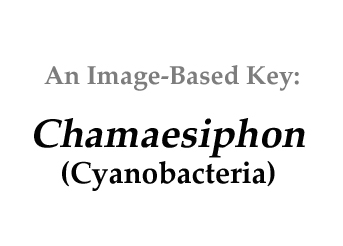 |
 |
|||
|
|
||||
|
Click on images for larger format |
||||
Name derivation: |
||||
|
From the Greek chamai, meaning dwarf - or sometimes in botany signifying false-, and siphon, a tube).
|
||||
Classification: |
||||
Chamaesiphon A.Braun in Rabenhorst 1864; 33 of 89 species descriptions are currently accepted taxonomically (Guiry and Guiry 2013).Order Synechococcales; Family Chamaesiphonaceae.
|
||||
Morphology: |
||||
|
Cylindrical cells occur singly or in groups, attached by their base to substrata. Cells of this genus produce one or more spherical exospores(or exocytes) - asexual reproductive cells that are cut off from the apical end of the parental cell, and bud off through the open, slightly widened top end of the parental cell's sheath. Division mechanism producing exospores has been described as ‘budding’ (unique in cyanobacteria, Waterbury and Stanier 1977), or as identical to typical cell division of cyanobacteria (Gromov and Mamkaeva 1980).
|
||||
Similar genera: |
||||
|
|
||||
Habitat: |
||||
|
Most species are found attached to substrata in the running waters of cold streams. Others are commonly found on surfaces of aquatic vegetation in lakes. Epiphytic on Tolypothrix, Cladophora, aquatic mosses, and Paralemanea catenata (freshwater red, Kučera et al. 2006). In Norwegian rivers the specific pH optima for eight Chamaesiphon species is 6.45 – 7.33 (Schneider and Lindstrřm 2009). |
||||
References: |
||||
|
Gromov, B.V. and K.A. Mamkaeva 1980. Cell cycle characteristics of Chamaesiphon confervicola, a cyanobacterium forming exospores.. Mikrobiologiia 49(4):551-554. Guiry, M.D. and Guiry, G.M. 2013. AlgaeBase. World-wide electronic publication, National University of Ireland, Galway. http://www.algaebase.org; searched on 27 August 2013. Kučera, P, B. Uher and O. Komárek 2006. Epiphytic cyanophytes Xenococcus kerneri and Chamaesiphon minutus on the freshwater red alga Paralemanea catenata (Rhodophyta). Biologia, Bratislava, Section Botany 61(1):11-13. Schneider, S. and E.-A. Lindstrřm 2009. Bioindication in Norwegian rivers using non-diatomaceous benthic algae: The acidification index periphyon (AIP). Ecological Indicators 9(6):1206-1211. Waterbury, J. and R. Stanier 1977. Two unicellular cyanobacteria which reproduce by budding. Archives of Microbiology 115:249-257. |
||||
|
Home / Cyanobacteria / unicells / Chamaesiphon |
||||

